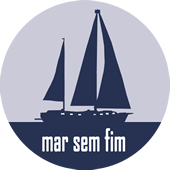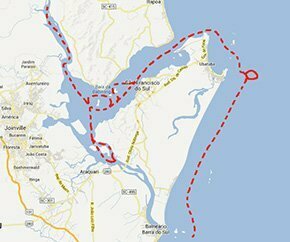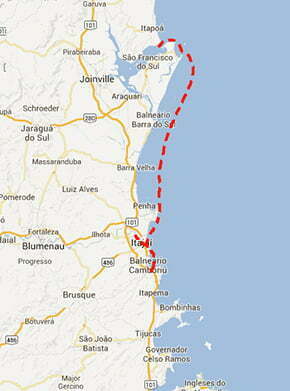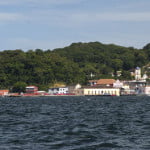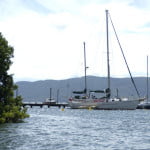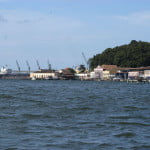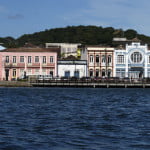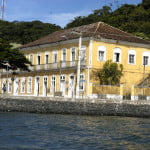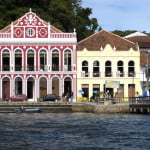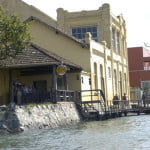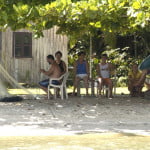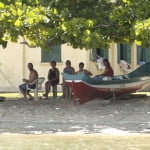Wednesday, 17 – 01 – 2007.
One more year and the third one of our project. Everything started in the middle of 2004. In July/August, the Endless Sea left Santos and sailed to the Oiapoque River where our series would start. In September 2004, since the sailboat had already arrived in Recife, I boarded it to go up to Natal via Fernando de Noronha.
Afterwards, Alonso and I left the capital of Rio Grande do Norte to go to the Oiapoque River, more than a thousand miles northwards. Nadia Megonn was on board. We had eleven days of calm sailing.
In December, we anchored in front of the district which is at the north end of Brazil and then we returned by plane to São Paulo.
One month later, at the beginning of 2005, we started traveling and recording. A few months later, the first episode of our series was broadcast by TV Cultura on the first Sunday of April, 2005.
From that moment on, we have recorded 78 episodes and left behind us more than 5,300 miles, sailed alongside the coast of 15 out of the 17 Brazilian coastal states. Right now we are preparing ourselves to finish this phase of our work. Yesterday, we started recording the antepenultimate state, Santa Catarina, and we decided to start by the bay of Babitonga where the district of São Francisco do Sul is, in the northeast of the state.
The last episode we recorded last year showed the bay of Guaratuba, in the south of Parana. We restarted the series this year recording the south of Santa Catarina. The bay of Babitonga is famous not only because it shelters the island, but also the district of São Franciso do Sul, where this state was first colonized.
The first European who arrived here was Binot Paulmier de Gonneville. A French sailor and trader who was aware of the “Indias’ Route” by Vasco da Gama, in 1498 and decided to take a chance in the spice business. He put in his ship, L’Espoir, 60 crew members and left in July, 1503, in search of the richness of the “East”. From the port of Honfleur, in Normandy, he went to the Canary Islands, on the coast of Spain. And then he went to the Cape Verde Islands owned by the Portuguese. Afterwards, he sailed to the southeast, crossed the Equator line and then realized it wouldn’t be that easy. At first, he floated for months and faced either monotonous calms or devastating storms. It was so difficult that he gave up doing the spice business as well as the route that would take him to the Cape Good Hope. He did a U-turn and sailed to the West. The same quadrant which a few years later brought Cabral to our coast.
In January 1504, Gonneville arrived in the bay of Babitonga, a well sheltered natural port.
That’s where he wrote the first chapter of the History of this part of Brazil.
His arrival and stay could be turned into a good film. The bay with its calm waters was pleasant, perfect for a long anchorage. Surrounded by the splendid Atlantic Forest and Mountains, from where several rivers came and flew into the bay. There were Carijos Indians who welcomed foreigners very curiously and politely. They took advantage to satisfy their thirst and hunger and abandoned themselves to “the pleasures of the flesh”.
The ship was repaired, illnesses were cured and forces were recovered.
Six months later, feeling O.K., supplied with provisions and maybe bored with their easy life; they gave up the idea of going to India and decided to return to Europe. Before leaving, a trophy was necessary. They took with them on board the son of the Indian chief, called Iça-Mirim, who they called Essomeriq. They promised to bring him back in “20 moons”.
When they returned, they faced lots of sailing difficulties. But a worse thing was to come. When they were about to get back home, in the English Channel, l’Espoir was attacked by pirates. That was too much. The commander, devastated by the long adventure, didn’t want to fight . Instead, he preferred to make his men ground the ship. After they fought, he left the ship with the crew members left: less than half of the crew, 28 people. Iça-Mirim was among them, but he had been rebaptized as Binot, he was named after his “discoverer”.
Historians say that our hero Carijo got married in France with a member of the commander’s family. He lived in France for over 90 years and left behind 14 direct descendants. He never returned to Brazil.
Thursday, 19 – 01 – 2007.
In previous logbooks, I have already mentioned Paulina’s talents, this Chilean I met when she was a journalism trainee at Radio Eldorado. Yes, she is Chilean. In spite of being brunette, no accent at all and a very resourceful person.
I’ve been aware of her skills since 1998 when she became Eldorado’s team member. At that time both radios (AM and FM) had eclectic programs which were innovative, politically involved and daring. Environmental matters which had been kept untouched so far were on the spot. Remarkable campaigns were launched such as the cleaning up of the Tiete River. We also supported vehemently other campaigns such as the Atlantic Forest cause. We didn’t broadcast stupid things. Debates were carried out in our studios and then we followed the reactions. We invited our listeners to participate and give their opinions on issues involving environmental laws which were about to be voted by the city councils. A few days later, thousands of messages flooded the council-chamber and public opinion was heard. Fabio Feldmann, former secretary of Sao Paulo’s Environment Department confirmed during several interviews the devastating effect of the messages. This issue was increasingly important and controversial and attracted other means of communication. It became significantly noticeable.
At that time, people from S.O.S. Atlantic Forest were all the time at Eldorado. It was as if Mario Mantovani had an office room at the radio. He had been hired to be in charge of Nucleo União Pró-Tietê, which had been created by Radio Eldorado and S.O.S. Atlantic Forest.
Paulina worked and gained experience in this field and very soon she was noticed for her enthusiasm, for being involved and willing to do the most unexpected tasks as well as for being constantly in a good mood. I have already mentioned that. Well, since there is some time left I would like to describe each crew member. Paulina is a great producer! It’s been a long time since she started to share tasks of the program with me. And she carries them out well. But as a producer she is outstanding. She snoops around, pries, calls dozens of people. She checks our heavy agenda; studies possibilities and invariably finds fantastic people on each inch of the Brazilian coast. Sometimes, I think it is unbelievable. Now, for instance, she got in contact with Ameca, Sao Francisco’s NGO through Ana Paula Cortez, one of its founders and current vice-president.
We met her last night and talked at the picturesque bar of the museum’s pier where we had anchored. Her action faced obstacles but was successful as well. It is more evidence that it is worthwhile to believe even if forces are unequal. I will tell things little by little. It is worth enjoying each part of it.
For the time being, what matters is that we’ve decided to go together to the confines of the Palmital River (on the north side of the bay) this morning.
The crew was ready at 8 a.m. Everybody had had breakfast, taken the necessary equipment, and were ready for action.
We got on the support boat and supplied it with fuel. At the Yacht Club, in front of the old center, Ana Paula, the funny lady from Angola was waiting for us. She is the main character of this part of our trip.
We sailed to the back of the bay. As Ana Paula guided us she told us about Amec NGO’s fights (Associação Movimento Ecológico Carijó) since it was inaugurated, in 1987. It is the oldest NGO operating in the district.
Problems are serious as usual. First of all, the Linguado Canal was at the south end of the São Francisco Island. This canal was the south bar of the bay of Babitonga until the beginning of the 20th century. It was filled with earth to enable the construction of the railroad which used a movable bridge. This was designed by a North American investor, Percival Farquar.
At first (1904), just one part of the canal was filled with earth; on the Linguado Island which is
right in the middle. The other part remained opened and that’s where the bridge was. The effect of this change on the geography was a narrower area to make the water flow and a much stronger current. The waters started to erode the banks and to obstruct the deep bed. This process continued until 1935 when it was decided to close it definitely.
This is the situation today. However, there is no more railroad on the filled area; instead there is a road connecting Sao Francisco and Joinville. The island is gone. The entire bay changed. The filled land changed the water flow completely. Today, the average depth is 6 meters at most and there are communities which are almost isolated. Araguari is one of these communities where lots of non-industrial fishermen live. The sheet of water is so thin that they can only go fishing at very high tides.
Since one of the canals to the sea was closed, the bay was less irrigated. At the same time, the bay started to retain all the dirt from the four big basins (the Cubatão, Palmital, Cachoeira and Parati). Additionally, there are smaller ones which flow into the bay.
Pollution results from different sources: industrial and human waste as well as that from agriculture due to the use of fertilizers and pesticides.
Levels above the maximum allowed limit for heavy metals such as chrome and zinc were already found. Chemical contamination was also found with high levels of mercury, nitrogen and cadmium (Source: in Povos e Aguas by Antonio Carlos Diegues). Everything has the same origin: Joinville and its industrial pole (one of the biggest in the South) and its 420 thousand inhabitants (less than 20% of their houses have waste system. Source: IBGE, 2000). The waste of the city is thrown daily into the bay via the Pirabeiraba and Cubatão Rivers.
Pesticides come from cultures in the surrounding areas, especially Joinville, Araguari and Garuva. To make things worse there is a port (one of Brazil’s 10 biggest ports in terms of cargo) and a terminal to receive oil through a monobuoy anchored five miles away. A tube system brings the oil to the island where the separation of the “formation water” is carried out, in a Petrobras’ center, and then, the gross oil is sent to Araucaria’s refinery, in Parana, through a pipeline.
From the moment it started to operate in the 70’s until the beginning of the 90’s, Petrobras threw the “formation water” into the Acarai River which flows in the island. However, Ameca sued Petrobras. The situation was examined and it was proved that there was water contamination. It took some time, it was a demanding task and it required a lot of effort, but they were successful: they were the prevailing part and the company was forced to stop this type of activity.
Ana Paula told us about several legal battles. Besides Petrobras, they pressed charges against lots and condominiums in irregular areas; they also made Vega do Sul put a pipe turned towards the sea for the industrial waste (the company wanted to throw it into the bay). They were also able to demolish improper buildings, one of them involving the mayor’s son. But that’s not all. They sued Sao Francisco do Sul’s city administration (32 thousand inhabitants and less than 10% of the houses have waste system, according to IBGE) since basic sanitation is not properly taken in charge. It’s unbelievable, but they were the prevailing part again. They have a small team and no funds. Ameca doesn’t even have a web site. I asked if they didn’t report to the press. “No, it’s useless, they don’t publish. If they do so, the city administration will stop sending the few advertisements they put on their papers.” They don’t have lots of funds. However, there are plenty of examples of how putting citizenship into practice. Ana Paula and her fellows report and very often press charges against the Public Prosecution Service. Sometimes they teach simple things to their peers. But then they have excellent results.
“If you want to contribute to the environment you have to change your habits”, this is the main advice given by nine out of ten environmentalists. This is what Ana and other five Ameca founders did. Now, their victories show possible ways. Let’s spread their example, thus we help to give origin to new ones.
These are the pressures the bay of Babitonga is submitted to, with its 1400 square kilometers, countless islands (the biggest is São Francisco with about 300 square kilometers) and several ecosystems. 6,200 hectares are covered by mangroves. This is the biggest mangrove area of the south of the country. Additionally, there are beaches, islands, reefs, flooded areas, Atlantic Forest and dunes.
During our visit we could observe some of these things. Mangroves are well preserved, but several “holes” are found in the back of the forest; this means they are replaced by domestic agriculture, pasture and above all by banana plantations.
Along the last navigable kilometers of the Palmital River; quite near the district of Garuva, there are a few pousadas which didn’t spare mangroves for settlement purposes: areas were filled with earth, cement walls were built around the bed of the river, cement ramps were built to make the boats go down, everything irregularly. They are not too many; the devastated area isn’t big either. But it is a bad start for ecological tourism.
On our way back to the bay, we saw a few irregular houses built on the rocky coasts on the shore of some islands. One more time, local educated inhabitants give the worst example. They buy properties and then huge summer houses are built and the idea of adapting the architecture to the local style doesn’t exist at all. That’s how parts of the wonderful natural scenery which took years to be created and belong to everyone, an inheritance received by previous generations, are unmercifully erased. Changed for worse and forever.
We returned to the Endless Sea at the end of the afternoon.
It is full of visitors, as usual. It is like this everyday. People come to the museum and then walk around the area. They see the Endless Sea, come on board, get into the cabin, take pictures, it’s joyful. Alonso is the guide of the team. Here, in São Francisco, he is always surrounded by fans. It’s very nice.
Friday, January 19, 2007.
We had a very bad news today. Dalmo Vieira Filho, designer and first director of the Sea National Museum, won’t be able to come with us as was arranged.
Sao Francisco do Sul, like I told you in the last logbook, has the privilege of having this fantastic museum. The only of this sort in Latin America, this museum has about 50 different types of traditional vessels such as cutters from Maranhão, lighters from Bahia, rafts made of piuba, many types of canoes, as well as trawlers, baleeiras, support boats, bianas, igarités, etc. This is the result of Dalmo’s work, a visionary, fond of typical vessels and the mysteries of the construction, known only by the memory of craftsmen, carpenters, calkers and other masters who gained this know-how with time. And then progress arrived and in some cases, their craft was cut out. To preserve it, Dalmo, helped by Iphan, São Francisco’s city administration and other abnegate were able to found the Museum at the beginning of the nineties.
It is wonderful. There are not only original boats, but also tools used by fishermen, those who actually use them. You can see maps showing the area where they were built and used adding information on their construction. It is also remarkable a collection of perfect miniatures made by different craftsmen and it also brings back models which are extinct today. You can find as well an emblematic boat, Iat, the oar boat used by Amyr Klink to cross the South Atlantic. Klink became famous when he proved it was possible to cross the Atlantic not using the shortest geographic distance; instead, he took the longest route (he sailed hundreds of additional miles) which offered better conditions in terms of currents and winds. “Invisible roads”, that’s how he called this route. This is explained in his book “Cem dias entre o Céu e o Mar” (A hundred days between Heaven and Sea).
There was a misunderstanding about the dates when we arranged the interview on the phone. Now, the present director is telling me Dalmo won’t be able to come. What a pity! Our program would have been better with him.
Anyway, we were supposed to explore something else today. This time we will be followed by biologist Marta Cremer to sail along the other side of the bay. Yesterday, we sailed northwards; today we will sail southwards. We will use the support boat until we reach Linguado barrage. Meanwhile this biologist will let us know about Toninhas, the smallest species of dolphins and the only family of cetaceans threatened with extinction on Ibama’s list. The curious thing is that they chose the estuary of Babitonga as their habitat (gray botos also come to this area).
Why here? I asked. What is the special thing in this bay that attracts Toninhas?
“Good question”, answered Marta. “We haven’t any answer for the moment.” She told us they have very discreet habits, “they are primitive animals and belong to pink botos’ family. They are the smallest in size; their weight ranges from 60 to 80 kilos. The shape of the “face” is slightly different: “quite elongated, with lots of teeth. It also has a very small dorsal fin.”
Marta explains that “since they have a discreet behavior, observation is very difficult”; consequently “very little is known about their habits”.
What counts is that this is the only estuary where a small group of individuals (not more than fifty) live. And this is one more proof of Babitonga’s rich biological biodiversity. Toninhas are also found in the sea, from Espirito Santo’s coast to Argentina. They are also known as Cachimbo or Yellow Boto.
We left early, as usual, with very hot sun softened by the boat’s awning as well as by the wind resulting from the speed.
As we sailed westwards, to the back of the bay, we passed in front of one of Vega do Sul’s tower; a company in the neighborhood which laminates steel. It reminded me of what Ana Paula told us about the company. Vega do Sul intends to build its own terminal; this means a small port for the outflow of the production. And this is not the only one.
The second port in the bay has already been approved. It is in Itapoa, almost in front of today’s port and basically for containers. Additionally, there is Vaga do Sul’s project as well as another for Laranjeiras; a beautiful and calm sub-bay almost in the back of the main bay.
If there was a contest of threats, Babitonga would have no competitor. Fortunately, especially for environmentalists, probably these two new ports won’t be approved.
At the same time, there is a project which Marcia explained to us. A sort of “partnership” between the Federal University of Joinville and Ibama to turn the area into a Fauna Reserve.
Univille carried out studies and gave them to Ibama. This agency accepted the idea and presented a proposal (February 2005) to create a Conservation Unit under the category Fauna Reserve (two public consultations have already been made). The area which has to be protected comprehends the entire sheet of water (except Sao Francisco’s port which exists for over 40 years and the frontal area of the city), mangroves and the contiguous coast until the isobath (the line which shows the depths on the nautical map) of 20 meters.
We continued and arrived in the back of the bay which was covered by hundreds, maybe thousands of cormorants. We had never seen so many. We approached very slowly. We didn’t want to frighten them. And they allowed us to see them. However, when one flies all the others fly after. It is nice to watch them. These birds are funny, careless. They find it difficult to take off, they rebound on the water, sprinkle everywhere and fly near the water one next to the other. A private show. We turned left, passed in front of a small fishermen’s village, avoided invisible sandbanks, guided by Marta, until we reached the Linguado Island. And then we watched the second part of the show: a small group of Colhereiros perched on a mangrove tree. One more time I approached slowly and turned the motor off. We could also hear bell-birds peep echoing in the forest.
As we heard the symphony, we took pictures and shot the birds and their pink feathers and the peculiar spoon shape beak. We stayed there for half an hour looking at their beauty and appreciating the sound coming from afar.
Further we saw one more group of birds, Ostreiros, with their live red beaks.
And then we reached the limit of our draught; two miles were separating us from the barrage. But we could see the road with cars and trucks. It is a pity the long-lasting decision to open the barrage again. Marta and Ana Paula explained that nobody is against opening it; they simply don’t know how to do it. Maybe they will just keep the north canal closed and open the south canal.
While the best option is examined, they work on making people aware who live in the neighborhood of the bay and inform that not all the problems will be solved. Suspension and turbidity will be present in the water for a couple of years. Nevertheless, opening the barrage and the reserve are favorable news.
It was not late when we finished sailing. We dropped Marta in the city and went to Helio’s Restaurant to taste his food, on the other side of the canal; we also wanted to interview the owner. Seu Hélio is a former native fisherman who also adopted the crustacean culture with oyster and mollusks tanks.
As usual, there is East/Northeast wind, from 12 to 15 knots, which is enough to agitate the sea and make small waves in the bay. But the wind is also refreshing.
We crossed the canal, left the boat at the pier of the restaurant and chose a table under the crown of a huge Chapéu-do-sol. We were protected by the shade of the tree, had the view of São Francisco in front of us and were showered by the sea breeze. We had lunch and interviewed the owner. We had a very nice afternoon; there is nothing to complain about.
We returned to the Endless Sea and while I was taking a nap in the cockpit, I heard hubbubs at the pier. I woke up. It was a program’s fan who wanted absolutely to take a picture with the “commander”. I went there to pay back the TV viewers’ kindness.
Saturday, 20 – 01 – 2007.
Yesterday, the sun didn’t help us to go any further as we approached the barrage. It wasn’t possible to shoot it the way we wanted to. We are going back today by car to have new shots and show exactly the way it was built. We will also go to the beach in the south bar to see the occupation and the entrance of the canal. The area of the bar of the canal has been changed quite significantly by human action. The beach is long and clean in spite of the high number of people who come. Countless constructions are on movable areas. Especially those which are in front of the sea; the same areas that have been submitted for thousands of years to the major action of the winds, currents and waves, tides, rains and the gradient of the soil, among other factors (such as real estate speculation) which little by little erode, cut and design again the contour of the coast. These are the reasons why that the mouths of the rivers are movable. They are sometimes here, other times over there. This explains why these sensitive areas are protected and shouldn’t be occupied. The fragile aspect, the importance for maritime life and above all the movable fact are natural hindrances. But white man insists. And spoils it. In spite of having this additional example which shows that the course of the rivers shall not be changed, houses shall not be built near the sand of the shore; this is a recurring problem on the coast of Brazil.
Here in Iguape, in the rivers of the Baixada Fluminense, or in the barrages made alongside the Sao Francisco River, the consequence is always disastrous: erosion, obstruction, decreasing biodiversity and worse social crisis. It is about time to regret and respect the curves, contours and drops caused on nature by the action of time. And we shall not change it any more. If this is the contribution, the dismounting of the Linguado Canal Barrage will be a double victory.
After the morning visit, we had lunch in the city and returned to the boat. I had a hard task: to write the logbook.
Sometimes, it is easy, it is written at once. Sometimes, every word is hard. Sentences don’t match. Ideas hardly come up. And each sentence is pulled away from the computer; being repetitive and lacking of objectivity is an increasing fear. In these cases, the effort to have a minimum of originality and to be faithful reaches huge proportions. I spend hours in the cabin trying possibilities; it’s a sort of dry sauna, I sit at the plotting table, the computer is in front of me.
This is the case for logbook 29. It has been tougher in regard to the writer’s abilities.
The end of the year’s vacation didn’t do me any good.
Sunday, 21 January 2007.
This early morning I cursed Alonso. I was sleeping profoundly when at five a.m. the noise of the motor exploded in the cabin. I looked at the hatch-way and saw it was dark. I closed it; turned to the other side and slept again as if it had nothing to do with me.
He was unmooring the boat. An hour later I woke up. The bar was at our prow. I was supposed to record part of the program.
A little bit dizzy I brushed my teeth, put a shirt on, had a cup of coffee and left. Cardozo was waiting for me, we had arranged a meeting with him.
Outside there was also an unexpected coadjutant: south wind at a speed up to 25 knots. Against our 60 mile sailing to Itajai.
We gave it up. It’s not worth being against nature. If it doesn’t want us to go any further, it is better not to insist.
This is one more rule; it is not written but if you disobey it will cost you a lot.
We returned. We moored at the pier of the museum at 10 a.m.
I sat again at the plotting table and I just left it to have lunch and short breaks during the day. And that’s where I am now at 10:40 p.m.
We will try to leave again.
Monday, 22 – 01 – 2007.
Today, Alonso hasn’t even tried to turn the motor on. When he woke up, he looked at the sky, saw clouds going from one side to the other. Taking into account his experience, he noticed that the south wind was still strong and didn’t wake us up.
But at 10 a.m. we took a taxi and came to Itajai; the second part of this trip and the second program to record. We had scheduled several interviews.
It is better to make them now.
Afterwards, we will return, bring the sailboat and shoot the landscape on our way back. In São Paulo, in the editing studio we put the parts together to have a full program.
Fishing in Itajai is like cinema in Hollywood. That’s why we spent the afternoon with Ibama’s people, at CEPSUL (Research Center and Fishing Resources Management of the Southeast and the South Coast).
We learned a little bit more.
We were welcomed by Luiz Rodrigues, head of the autarchy during the last four years.
The Itajai Valley area represents 40% of Brazil’s fishing production. Recent data. Source: SINDIPI ( The Union of the Fishing Industry of Itajai and the Surrounding Area).
When we started our conversation, I asked what Ibama thinks of scientists’ recent research, published by Science, saying that from 2048 on fishes and other maritime animals such as mollusks will collapse, if the fishing activity and the habitat devastation continues at today’s rhythm. The study which went beyond the academic universe and echoed in the international press show that this is already the situation today of 29% of maritime life, including birds, plants and microorganisms. Scientists believe that in 2048 the ENTIRE maritime life will be in the same situation. . It will decrease drastically, around 90%!
When I asked about the agency’s policies to face or attenuate the situation if this hypothesis is confirmed, I got no answer.
It was clear that there weren’t any. We must say that the catastrophe is real and is approaching and Brazilian official authorities have nothing to say about this challenge (caused by a worldwide lack of policies of maritime exploration and occupation of the coast).
I continued. There is nothing new about the lack of planning from public agencies. I decided to ask about this issue since when we talk about Santa Catarina, fishing means a lot.
The union gives us unbelievable figures: Itajai and Navegantes produce over a million cans per day. There are 250 ship owners with 700 vessels at the top of the fishing effort. Altogether this activity offers 15 thousand direct jobs and 50 thousand indirectly. Most fishing companies are established in Itajai. Altogether they fish over 220 thousand tons per year.
Don’t be astonished! This figure was higher in the past. In the 80’s, 120 thousand tons of sardines were taken from the sea.
I have already explained in previous logbooks that we have a huge coast with a little fishing biomass. We have tropical seas, less rich in nutrients than temperate seas. Consequently, there is a decreasing fishing biomass. The exception is the mouth of the Amazon River whose richness is evident and from this point of the coast until Rio Grande do Sul.
The Brazilian seas have a great biodiversity, but that’s all. This means a variety of species; but the amount of the species that interest the fishing industry or its biomass is small.
Additionally, there are conflicts politically speaking, antagonistic interests in the productive sector which “complains a lot” according to the lobby of the economic power and disputes between non-industrial and industrial fishermen. Nevertheless, Ibama has no funds, structure, precise policies, equipment and people, neither effective laws to be obeyed and followed.
That’s why the head of the agency said (off the record) before we started the interview that “fishing in Brazil is completely chaotic”.
There is no doubt about that. We are tired of seeing and reporting on this buffoonery. This is the result of mean interests and trivial public policies. Everybody knows that. The only thing that can be done is to try to understand it.
I asked about using the trawl-net and I got a bombastic answer (off the record): “it is easier to extinguish Ibama than trawl-net fishing.”
In regard to inspection, especially on the distance from the coast where trawl-net fishing is used in each state (each one determines the minimum distance ranging from one to three miles), I asked: “Is it possible to have an ostensive or intensive inspection?” And before I continued, he replied: “there is lack of people and equipment.”
But I insisted and asked: “Who is responsible for that?”
“We are.”
I got at least recognition.
I tried to separate the issue geographically. I suggested questions on ocean fishing, before asking about coastal fishing, which is important here.
Luiz called an adviser who didn’t know how to answer any of them. He knew neither the volume captured nor how big the national fleet was. He didn’t know our share of the migratory shoal, especially tuna or fishes of the sort. He also ignored the amount of boats with flags from other countries rented by local ship owners. Instead, he stammered about an international conference in which he participated with other Brazilian experts. He said that they could probably answer those questions. He was kind and promised to give their names and telephone numbers. He left afterwards without showing the reason why he was there.
We continued.
I changed the geographic area and the main interest. I tried again and asked about the sardine and mullet collapse: they are both coastal fishes and still very important in the South and Southeast, in spite of overfishing.
Sardine was the first issue. It has already represented 120 thousand tons per year and it dropped drastically to 17 thousand in 2000. “Today they pray to reach 40 thousand tons/year.”
We talked about the reasons of this collapse. Urban and industrial pollution, predatory occupation of the coast, pesticides, vanishing habitats, global warming; the list is very long. The omission of public authorities must be included.
Secondly, we asked about technology which is increasingly developed and enhances fishing effectiveness. According to Luiz, one of the most harmful modern technologies is “power block”, that is the hydraulic system of pulling the net.
“Since the fishing fleet started to use it, it was increasingly faster; consequently, the number of times the net was thrown was bigger. Besides, they are much bigger than those handled by human force.”
Of course. The seas are as big as they have always been for thousands of years. However, the amount of boats has increased as well as the technology these boats have.
In addition to the countless environmental problems, the lack of laws and rules or the disrespectful attitude in regard to the existing rules, are relevant factors as well. All these aspects result in an alarming decreasing number of fishes. This is not new. An official answer for this phenomenon would be new.
Next we asked about the other end of this chain. Production and the resulting conflicts. (Industrial) tuna fishermen also contribute to make sardines disappear. Since open sea fishing started, a few years ago, huge tuna fishing boats look for young sardines to serve as live bait. They attack creeks in search of shoals and this is against non-industrial fishermen’s interests who make their living from this activity. When the tuna fishing boat goes to open sea, it can take up to one million live baits or sardines when they are still growing.
In addition to taking away the food of the creek or the “backyard” of non-industrial fishermen, it contributes to worsen the situation of lots of other species due to the fact that sardines are also the base of the food chain for many of them. It’s important to know that tuna migratory shoals and similar species are abundant on the Brazilian coast. There are very few suggestions for this type of conflict and threat.
Easy? We know it is not. But someone has to do it. And many times this is what public administration has to do.
At certain moments, Ibama’s head criticized the few official policies such as the angler fishing in open seas since “it takes from 7 to 9 years to reach maturity which is too long”. Fishing will be either anti-economic in a short period of time or ship owners will extinguish shoals of the species.
Rodrigues said clearly what the difficulties and incoherencies one has to deal with officially. He explains: “Let’s see the tuna situation. Underexploited species like tuna are SEAP’s responsibility (Fishing Special Department). Ibama is in charge of overexploited species like sardines.”
Then how to deal with things in this case? You’ll be given a candy if you know the answer.
CEPSUL’s head concludes: “It’s an imbroglio.” He continued: “it is hard to make any progress, it involves powerful economic interests.” He is right.
This agency’s answer is to develop the breeding of live baits in captivity. It’s a long-lasting expensive process. This is what they do trying not to be involved in the conflict between industrial and non-industrial fishermen.
The fishing permission issue is chaotic too. Some people have the permission for the shrimp trawl-net fishing, others for fishes. However, when there are no shrimps, the first group uses the trawl-net to catch fishes. When there are no fishes, those who have the permission to catch fishes use the trawl-net fishing to catch shrimps. Is it possible to understand? This means that when there is no inspection, it’s every man for himself. Everything is possible. Now the situation is difficult; if there is a shoal which is economically interesting, the fishing industry attacks it without mercy. This happens all the time. According to Rodrigues “the only faithful fleet is sete barbas shrimp’s.”
Well, and then I asked? Will this chaos continue? When we were recording, he explained to us a plan full of details to “reexamine the entire fishing model in the South and Southeast”. Not really convinced but resigned to show something he knows that will not be “persuasive”; he said that they intend to separate the maritime space into areas and give permits only to certain types of boats for each of these areas.
I believe that this type of plan doesn’t change anything significantly, even if it is miraculously introduced. It is like the “team work” we heard of in Brasilia: hot air.
Ah, Lula’s administration created a policy which is the closed season salary, an amount that is paid by the government to the fisherman during the period a certain species cannot be captured. On this policy, before we started recording, Luiz Rodrigues said: “It is not serious. “After this measure was taken, there were fishermen everywhere. Nobody stops fishing and everybody receives money.” Ok, we have taken note.
The last question I asked was: ”Which is worse, lack of money for investment in research, people and equipment or lack of political will in this sector?
He was honest, as usual, we must say. He was sometimes sarcastic, sometimes ironic, during the interview. However, when I asked this last question, he came to the point: “We lack of everything, João. Money and political will.”
We went to another room and interviewed someone else. We talked to Ana Maria Torres Rodrigues, environment analyst, in charge of the fishing ordering sector. The crustacean culture is not enough studied and developed in Brazil. It is a complicated activity not only here but also abroad. In spite of having very little, Santa Catarina’s coast represents 90% of the Brazilian production.
The most significant activities are oyster, mussel, scallop and algae breeding. There is also the crustacean culture which she hates.
Ana flied and took pictures of the area of the bay of Babitonga, near the Linguado Canal where you see a shrimp breeding farm being built. There is an enormous devastation. She said that she will study this issue and if it is confirmed that it is built in mangrove areas, there will be an embargo.
“Santa Catarina’s coast has been devastated very rapidly.” And “there are conflicts on how to use it alongside the entire coast.”
She complains about the intensity of second residence tourism and confirms that “the city administrations don’t apply rules and sometimes don’t obey environmental rules, thus allowing the occupation of improper areas such as reefs, dunes and mangroves.”
I asked who was supposed to give permits allowing the crustacean culture. She explained that FTMA is (it corresponds to the state environmental department) and Ibama “interferes only when something is reported”.
Afterwards, Ana talked about how the crustacean culture started in the state in the 90’s when farms were established and started to operate with no permits. Since public authorities are unable to plan, they are always trying to repair damages. To put things in order, CEPSUL collected data to figure out the number of mollusks producers and find out the type which is cultivated and the size of the occupied area. Afterwards, CEPSUL would try to order them. Entrepreneurs were asked to fill up records with information on the localization of the occupied area as well as other specifications. 750 did it.
Having these data in hands, they checked it and found out that the vast majority had “reserved area for future growth” since they had written down they had “areas much bigger than they actually did.”
CEPSUL arranged a meeting with them to make them understand they had done the wrong thing. And then, in front of everybody, they compared real data with those given on the records, showing that most of them had run into false representation crime by reserving “public areas which were up to 100% unoccupied.” And then a technical report was produced and sent to the Federal Public Prosecution Service. This Service reported it to the police to start a civil inquiry.
Some producers signed a TAC (a pact of conduct) and they can continue their culture “temporarily” until things are definitely arranged with Ibama.
This episode was the origin of another conflict. This time with the UNIVALLI university which offered courses, seeds, and was the producers’ technical support.
Ana explains that this type of activity is found “alongside the coast of the state, especially in the north, north center and center part.” These last ones are more densely occupied. That’s where Florianopolis is. The problem is that they are “filtrating organisms” which “have been cultivated in waters contaminated by pollution due especially to the lack of sanitation”. There is a big public health risk.”
She explains that problems occur very often, like now when a new Red Tide was found in the area of the capital. “This happens in summer because during this period many people come to the coast. The weak sanitation collapses and more human waste is thrown into the sea. There are also high temperatures which cause more rain and this increases the number of organic substances in bays and creeks. This causes a chaotic proliferation of certain algae which are part of the phytoplankton. Some of these algae produce toxins which are harmful to the health or the Red Tide… When this happens the production of mollusks are embargoed, kept in quarantine and refrain people from eating these products “since there is the risk of having neurological, gastrointestinal problems and even tumors in the digestive organs”.
Did anyone say it was easy?
We will talk about these issues later. It was the end of the day and time to go back to the hotel.
Tuesday, 23 – 01 – 2007.
Today we are going to know more about the production chain and its keys. We have arranged an interview with SINDIPI’s president, Antonio Carlos Momm.
I started the interview asking how this sector faces the hecatomb predicted by scientists on professional fishing from 2048 on.
“Who are the great villains? The productive sector interested in being perennial or mangroves filled with earth, industrial pollution, the lack of basic sanitation, summer houses in improper places or public authorities who have never carried out a serious and all embracing study on this activity?”
All of them, I believe. However, I asked about something else: “Why does this part of the coast represent 40% of all the domestic fish?”
“Our platform here is very long, besides the Brazilian coast has two currents: a hot one (Brazil’s current which goes down the coast from the north towards the south, and a cold one (the Falkland Islands’ Current which goes up Antarctica on the opposite way) and both meet in Santa Catarina. This explains a superior fishing biomass.”
According to Momm, this is the reason why these seas “concentrate the biggest amount of migratory shoals of tuna and other similar species which are still available.”
“In regard to fishing public policies, what is SINDIPI’s opinion?” “I cannot say anything about that: there are no fishing policies.”
This statement showed one more conflict: the productive sector versus the government.
Before exploring this controversial issue I asked how much the coastal fishing (non-industrial and industrial) and the ocean fishing represent as a whole? “80% is coastal fishing.”
I also asked about SEAP which was created by Lula’s administration.
“Now we don’t go from one agency to another, from one State Department to another, and this is better. However, SEAP hasn’t carried out any study and there is no data bank either; work has been done with information used randomly. And there is no governmental policy.”
O.K. Let’s talk about ocean fishing. When did this activity start in Brazil?
“From 8 to 10 years ago.” What species are fished more often? “Tuna and similar species in addition to crabs, edible fishes, pink conger, anglers and others.”
And which is the biggest problem in this activity? “The conflict between foreign and domestic boats.” One more …
Brazil doesn’t control the ocean fishing technology; however, it has a fleet of boats ready for this challenge. At the same time, the fishing of migratory shoals is discussed, ruled and conducted in an international forum, ICCAT (International Committee of Conservation of the Atlantic Tuna) an international agreement which Brazil undersigned with 30 other countries and follows or should follow the recommendations of this agency which also determines the amount captured by each country.
If we don’t have those proper, modern, murderous, expensive and high tech boats, what can we do?
Leasing is suggested by the government and after the vessel is used for a certain period of time there is the possibility of turning it into national.
However, SINDIPI doesn’t think this is a good measure. Like in other sectors of economy, SINDIPI prefers the market reserve.
Antonio betrays himself when he expresses his opinion, it is clear he fears the possibility of having other “players” in this business. “Leasing allows anyone to become a ship owner and explore this type of fishing.”
The union was clear. An official statement was written and sent to the press and government agencies.
Here is the summary: “The fishing sector is discontented with the bill presented by the Federal Government (approved on November 21, 2006) which created the Brazilian record for foreign fishing vessels leased or freighted by companies.”
The statement mentions several reasons and reminds that the Environment Department had published “studies which limited the fishing of 384 species thus turning the whole fishing sector impractical, Normative Instruction Nº 5. Further on: “we think it is strange that Brazilian vessels are submitted to restrictions of geographical areas and fishing time according to scientific technical understanding (that is Ibama, this I have included myself) stating that species are affected by significant fishing, at the same time fishing is available on Brazil’s coast for foreign vessels.”
At last, he asks “the federal government to be coherent since the bill will be submitted to the president’s approval.”
Antonio also complains that union boats cannot fish in the Northeast whereas Espirito Santo’s fleet, especially from Marataizes (we visited it) often go fishing in southern waters.
According to the information I got, there are only 6 foreign boats operating in Brazil. All of them fish tuna and use the Long Line method.
I tried to talk again about coastal fishing and the conflicts between the industrial and non-industrial activity. I mentioned the case of live baits.
Antonio agreed and said that the problem actually existed. Tilapias have been used instead in order to minimize it. Fortunately, Santa Catarina’s Ibama discouraged the initiative because this is an extremely aggressive exotic species. And here another problem of the Brazilian coast becomes evident. Same situation and different measures. In Bahia (this has already been reported in logbook 17), state authorities encourage the tilapia breeding activity in estuaries, like in Cairu. However, Bahia’s Ibama has not stopped this dangerous experience.
What about mullets? I asked.
“They are most abundantly found in Lagoa dos Patos, in Rio Grande do Sul. When they leave the lagoon and go up the coast, trawlers from Itajai go there and fish in the mouth of the bar of Rio Grande; that’s why there is a decreasing number up the coast.”
This is confirmed by Ibama’s determination of an “exclusion area”. Boats are not allowed to throw their nets at less than a thousand meters from the bar. CEPSUL’s head said that Ibama is not able to control its own measure.
If there are trawlers which go to the mouth of the bar to catch mullets at the beginning of the annual migration, it is obvious that the law of the strongest prevails in the fishing activity.
Antonio Momm minimizes this, saying that “the mullet fishing has stabilized at five tons per year.” He concludes saying that non-industrial fishermen are also to blame: “when they leave the bar of Rio Grande, if there is wind they go up the coast and make non-industrial fishermen happy. However, if there is no wind, they go to high seas and then industrial fishermen are happy.” He criticizes Ibama when it allowed the non-industrial activity to fish mullets with mesh “which is forbidden all over the world, since even when it is lost and abandoned in the sea it kills maritime life.”
It is a shooting ground. There are shots everywhere. One more time, the winner is the person who has the best weapons. In regard to maritime biodiversity, well…
Before returning, we went to CEPSUL’s headquarters, this time to interview Antonio Miguel Miguéis, the coordinator of Albatroz (Albatross) Project, in Itajai, which aims at diminishing the accidental capture of these birds due to fishing traps.
And then our taxi took us to Sao Francisco do Sul where we arrived when it got dark.
A good shower, a good night sleep, that’s all we need. The weather is stable, we are sailing to Itajai tomorrow.
Wednesday, 24 – 01 – 2007.
We were able to leave early in the morning. The wind was lighter at night and there was no wind this morning. Since the night was not windy, squadrons of mosquitoes left their hiding places and the crew was eaten up. Slaps on the forehead to make them fly away, irritating buzzes on the ear covered by the sheet, the heat; all this made me sleep very badly.
At six a.m. we were at the mouth of the bar which was hard to cross. And then we sailed to Petrobras’ monobuoy out of the bar. Afterwards, we went to Itajai, 60 miles to the south. We came calmly with the motor on and helped by the genoa (the prow sail) and the mizzen (the aft sail).
At the end of the afternoon, we entered through the seawall of Itajai port where there were lots of big ships and fishing boats.
We sailed 10 miles up the river until it got lower. And then we returned, left the bar and went 6 miles down until we reached Camboriu. There is a marina where the Endless Sea can be left.
We arrived at nightfall and didn’t dare enter through the canal which leads to the marina.
We don’t know how deep it is. It is narrow and sinuous. We anchored in the bar where we are now. We have just seen the big amount of buildings on the shore.
Tomorrow will be the end of this trip.
Thursday, 25 – 01 – 2007.
When there was high tide, we entered through the canal and finally anchored our sailboat.
Before we grounded a little bit, as usual.
At the end of the day we returned to São Paulo.
